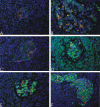Islet expression of the DNA repair enzyme 8-oxoguanosine DNA glycosylase (Ogg1) in human type 2 diabetes
- PMID: 12003641
- PMCID: PMC111186
- DOI: 10.1186/1472-6823-2-2
Islet expression of the DNA repair enzyme 8-oxoguanosine DNA glycosylase (Ogg1) in human type 2 diabetes
Abstract
BACKGROUND: It has become increasingly clear that beta-cell failure plays a critical role in the pathogenesis of type 2 diabetes. Free-radical mediated beta-cell damage has been intensively studied in type 1 diabetes, but not in human type 2 diabetes. Therefore, we studied the protein expression of the DNA repair enzyme Ogg1 in pancreases from type 2 diabetics. Ogg1 was studied because it is the major enzyme involved in repairing 7,8-dihydro-8-oxoguanosine DNA adducts, a lesion previously observed in a rat model of type 2 diabetes. Moreover, in a gene expression screen, Ogg1 was over-expressed in islets from a human type 2 diabetic. METHODS: Immunofluorescent staining of Ogg1 was performed on pancreatic specimens from healthy controls and patients with diabetes for 2-23 years. The intensity and islet area stained for Ogg1 was evaluated by semi-quantitative scoring. RESULTS: Both the intensity and the area of islet Ogg1 staining were significantly increased in islets from the type 2 diabetic subjects compared to the healthy controls. A correlation between increased Ogg1 fluorescent staining intensity and duration of diabetes was also found. Most of the staining observed was cytoplasmic, suggesting that mitochondrial Ogg1 accounts primarily for the increased Ogg1 expression. CONCLUSION: We conclude that oxidative stress related DNA damage may be a novel important factor in the pathogenesis of human type 2 diabetes. An increase of Ogg1 in islet cell mitochondria is consistent with a model in which hyperglycemia and consequent increased beta-cell oxidative metabolism lead to DNA damage and the induction of Ogg1 expression.
Figures






Similar articles
-
Immunolocalization of 8-OHdG and OGG1 in pancreatic islets of streptozotocin-induced diabetic rats.Acta Histochem. 2009;111(2):138-44. doi: 10.1016/j.acthis.2008.05.008. Epub 2008 Aug 3. Acta Histochem. 2009. PMID: 18676009
-
The C-terminal alphaO helix of human Ogg1 is essential for 8-oxoguanine DNA glycosylase activity: the mitochondrial beta-Ogg1 lacks this domain and does not have glycosylase activity.Nucleic Acids Res. 2004 Oct 19;32(18):5596-608. doi: 10.1093/nar/gkh863. Print 2004. Nucleic Acids Res. 2004. PMID: 15494448 Free PMC article.
-
Repair of 8-oxodeoxyguanosine lesions in mitochondrial dna depends on the oxoguanine dna glycosylase (OGG1) gene and 8-oxoguanine accumulates in the mitochondrial dna of OGG1-defective mice.Cancer Res. 2001 Jul 15;61(14):5378-81. Cancer Res. 2001. PMID: 11454679
-
The OGG1 gene encodes a repair enzyme for oxidatively damaged DNA and is involved in human carcinogenesis.Antioxid Redox Signal. 2001 Aug;3(4):597-609. doi: 10.1089/15230860152542952. Antioxid Redox Signal. 2001. PMID: 11554447 Review.
-
Involvement of mammalian OGG1(MMH) in excision of the 8-hydroxyguanine residue in DNA.Free Radic Biol Med. 2002 May 1;32(9):813-21. doi: 10.1016/s0891-5849(02)00778-5. Free Radic Biol Med. 2002. PMID: 11978483 Review.
Cited by
-
Mitochondrial DNA damage and dysfunction, and oxidative stress are associated with endoplasmic reticulum stress, protein degradation and apoptosis in high fat diet-induced insulin resistance mice.PLoS One. 2013;8(1):e54059. doi: 10.1371/journal.pone.0054059. Epub 2013 Jan 16. PLoS One. 2013. PMID: 23342074 Free PMC article.
-
Nutrient Sensor mTOR and OGT: Orchestrators of Organelle Homeostasis in Pancreatic β-Cells.J Diabetes Res. 2020 Dec 16;2020:8872639. doi: 10.1155/2020/8872639. eCollection 2020. J Diabetes Res. 2020. PMID: 33457426 Free PMC article. Review.
-
Altered expression of base excision repair genes in response to high glucose-induced oxidative stress in HepG2 hepatocytes.Med Sci Monit. 2012 Jul;18(7):BR281-5. doi: 10.12659/msm.883206. Med Sci Monit. 2012. PMID: 22739728 Free PMC article.
-
Association of telomere length with type 2 diabetes, oxidative stress and UCP2 gene variation.Atherosclerosis. 2010 Mar;209(1):42-50. doi: 10.1016/j.atherosclerosis.2009.09.070. Epub 2009 Oct 6. Atherosclerosis. 2010. PMID: 19889414 Free PMC article.
-
Excessive iron inhibits insulin secretion via perturbing transcriptional regulation of SYT7 by OGG1.Cell Mol Life Sci. 2023 May 20;80(6):159. doi: 10.1007/s00018-023-04802-y. Cell Mol Life Sci. 2023. PMID: 37209177 Free PMC article.
References
-
- Tyrberg B, Levine F. Current and future treatment strategies for type 2 diabetes: the β-cell as a therapeutic target. Curr Opin Investig Drugs. 2001;2:1568–1574. - PubMed
-
- Finegood DT, Scaglia L, Bonner-Weir S. Dynamics of beta-cell mass in the growing rat pancreas. Estimation with a simple mathematical model. Diabetes. 1995;44:249–256. - PubMed
-
- Sorenson RL, Brelje TC. Adaptation of islets of Langerhans to pregnancy: beta-cell growth, enhanced insulin secretion and the role of lactogenic hormones. Horm Metab Res. 1997;29:301–307. - PubMed
-
- Farnier M, Picard S. Diabetes: Statins, Fibrates, or Both? Curr Atheroscler Rep. 2001;3:19–28. - PubMed
LinkOut - more resources
Full Text Sources
Research Materials

